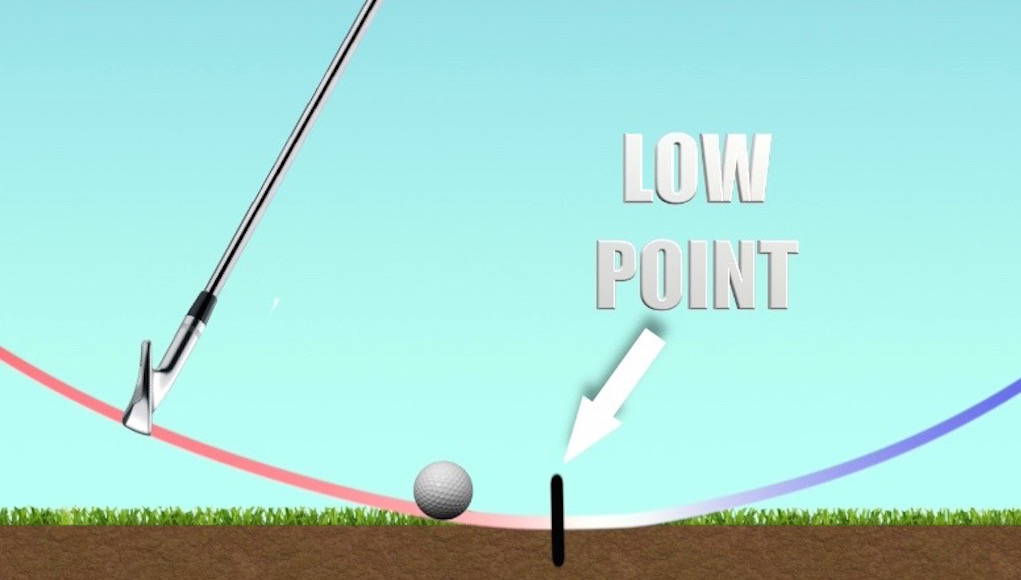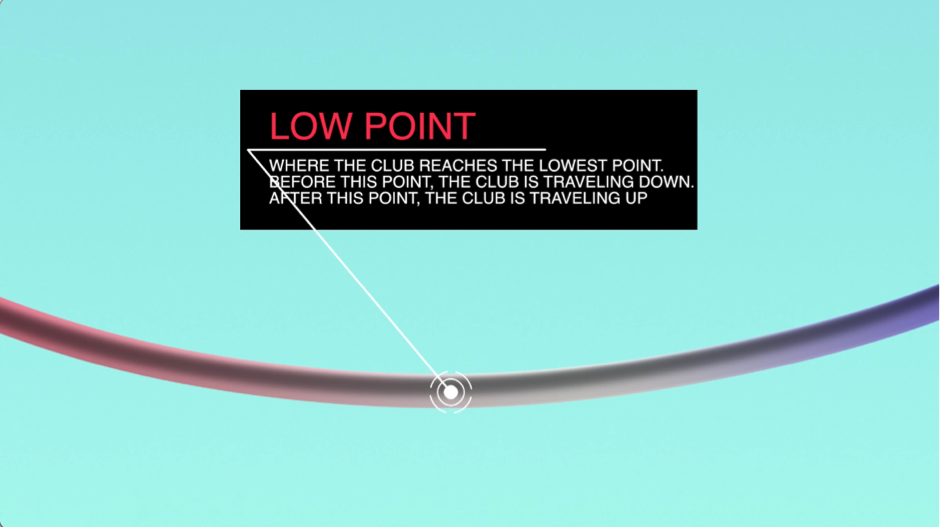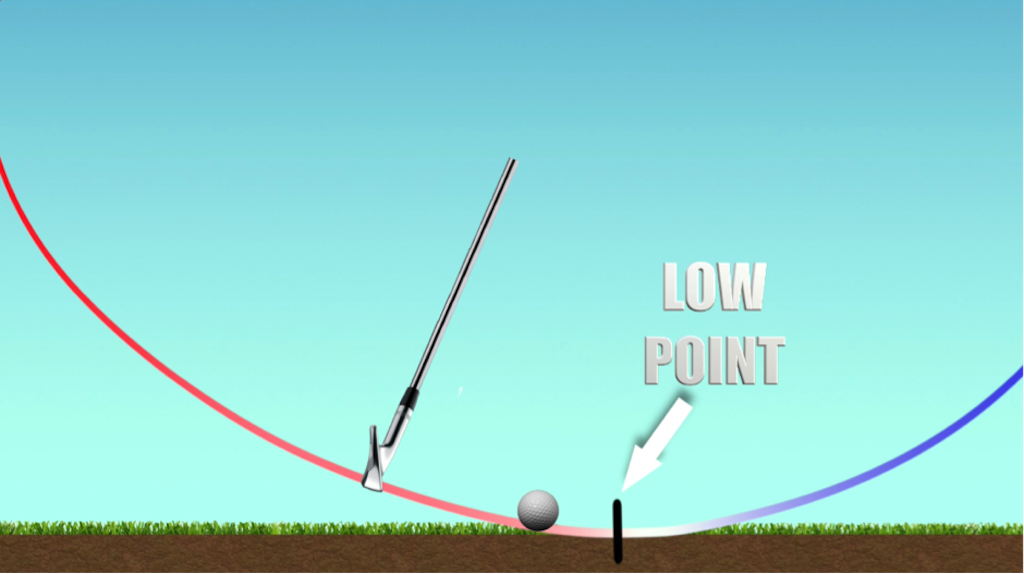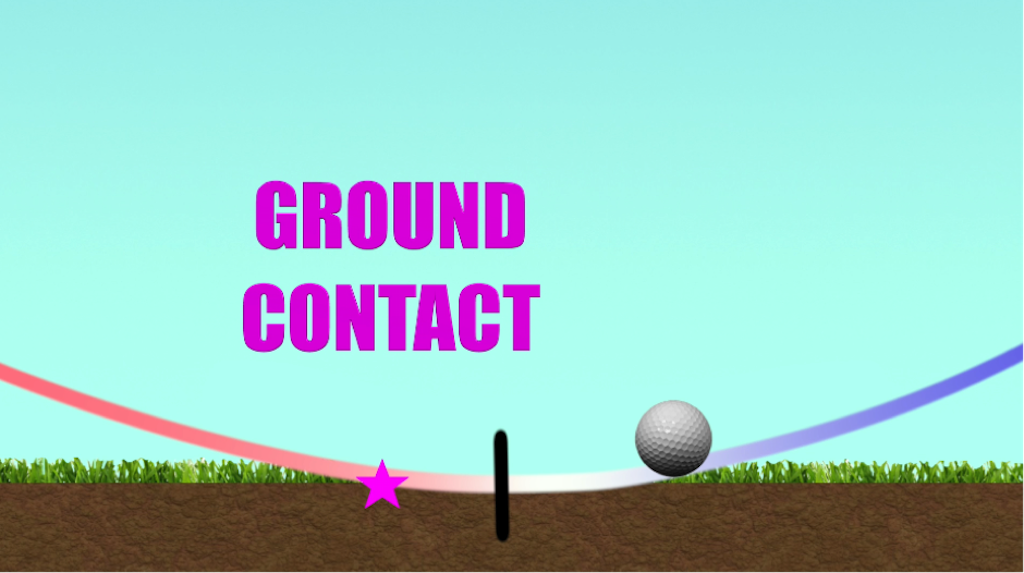Instruction
This thing called “Low Point” and how it can help your golf game

What is Low Point?
Anyone who has been on a Trackman device may have noticed a new number that calculates something called “Low Point,” which is very important to playing consistent golf. So what is it?
The low point number describes where the lowest point of the swing arc is (in inches) relative to the ball. On Trackman, you might see a low point number like 3.1A from a short iron shot, which indicates that a golfer’s club reached its low point 3.1 inches after impact. You also might see a number like 1.2B from a driver swing, which indicates that the club reached its low point 1.2 inches before impact.
Low point can occur either before or after impact due the circular/elliptical nature of the golf swing. It’s a little complex at first, but you’ll pick it up quickly. To better understand the concept, think of the golf swing as the big hula hoop. Zooming in on the bottom of this “hula hoop” (see the picture below), we can see the club is traveling downward during the red part of the swing arc. It then bottoms out in the white area (low point), before ascending in the blue area.
Where Should My Low Point Be?
Relative to the golf ball, for crisp shots from the turf, our low point should be in front of the ball, or after impact, as shown below.
The club would be traveling on the downward part of the swing arc as it contacts the ball. The lowest point of the swing would be in front of the ball (typically 3-5 inches with a 7 iron for a tour pro). This can change depending on the type of shot you have.
- A driver can benefit from having the low point behind the ball, potentially maximizing distance through higher launch and lower spin. My low point with a driver is as much as 9 inches behind the ball.
- Your low point can be more level with the golf ball if you have a nice, fluffy lie and are trying to pick your fairway wood off the turf.
- For shots where you may need a steeper angle of attack (e.g. out of deep rough), a more forward low point may be desirable.
Having your low point behind the ball with a shot from the ground will not work out well (especially on tight turf). You will either strike the ground very early, or even the smallest of raises in height will create a severely thin/bladed shot.
With the low point position behind the ball, we are stuck between a rock and a hard place. Contacting the turf will produce a drop-kick or a fat shot, but missing the turf will produce a thin shot.
How do I know what I am doing?
Getting your swing measured on a device like Trackman will tell you where your low point position is. However, for those of you without that option, there are enough clues in the turf to make a good assumption. If the middle of your divot is after (target side) of where the ball was before you hit it, that indicates that your low-point was in front of the ball.
Here is a great drill to check your low-point position.
Make swings taking a sliver of sand from the top. Because of the consistency of the sand, the middle of the divot will be a good representation of your low point position. With this drill, you can also check where your club first contacted the ground. This then gives you opportunity to experiment with different setups, swings, etc., in order to manipulate the low-point position to what you desire. Have fun and experiment.
Of course, this drill can be done from the turf, too, although your green keeper may not be too pleased with the divots everywhere. In a bunker, you can just rake the sand and start again.
Summary
There are a myriad of set-up positions and swing dynamics that create a functional low point position and I will go through them in future articles. However, getting a good grasp of the concept first is a big step forward in helping you achieve this task.
If you want to learn more about concepts, drills and techniques to improve your strike quality, check out The Strike Plan by visiting my website: www.adamyounggolf.com/the-strike-plan
- LIKE242
- LEGIT37
- WOW10
- LOL8
- IDHT1
- FLOP2
- OB3
- SHANK17
Instruction
The Wedge Guy: The easiest-to-learn golf basic

My golf learning began with this simple fact – if you don’t have a fundamentally sound hold on the golf club, it is practically impossible for your body to execute a fundamentally sound golf swing. I’m still a big believer that the golf swing is much easier to execute if you begin with the proper hold on the club.
As you might imagine, I come into contact with hundreds of golfers of all skill levels. And it is very rare to see a good player with a bad hold on the golf club. There are some exceptions, for sure, but they are very few and very far between, and they typically have beat so many balls with their poor grip that they’ve found a way to work around it.
The reality of biophysics is that the body moves only in certain ways – and the particulars of the way you hold the golf club can totally prevent a sound swing motion that allows the club to release properly through the impact zone. The wonderful thing is that anyone can learn how to put a fundamentally sound hold on the golf club, and you can practice it anywhere your hands are not otherwise engaged, like watching TV or just sitting and relaxing.
Whether you prefer an overlap, interlock or full-finger (not baseball!) grip on the club, the same fundamentals apply. Here are the major grip faults I see most often, in the order of the frequency:
Mis-aligned hands
By this I mean that the palms of the two hands are not parallel to each other. Too many golfers have a weak left hand and strong right, or vice versa. The easiest way to learn how to hold the club with your palms aligned properly is to grip a plain wooden ruler or yardstick. It forces the hands to align properly and shows you how that feels. If you grip and re-grip a yardstick several times, then grip a club, you’ll see that the learning curve is almost immediate.
The position of the grip in the upper/left hand
I also observe many golfers who have the butt of the grip too far into the heel pad of the upper hand (the left hand for right-handed players). It’s amazing how much easier it is to release the club through the ball if even 1/4-1/2″ of the butt is beyond the left heel pad. Try this yourself to see what I mean. Swing the club freely with just your left hand and notice the difference in its release from when you hold it at the end of the grip, versus gripping down even a half inch.
To help you really understand how this works, go to the range and hit shots with your five-iron gripped down a full inch to make the club the same length as your seven-iron. You will probably see an amazing shot shape difference, and likely not see as much distance loss as you would expect.
Too much lower (right) hand on the club
It seems like almost all golfers of 8-10 handicap or higher have the club too far into the palm of the lower hand, because that feels “good” if you are trying to control the path of the clubhead to the ball. But the golf swing is not an effort to hit at the ball – it is a swing of the club. The proper hold on the club has the grip underneath the pad at the base of the fingers. This will likely feel “weak” to you — like you cannot control the club like that. EXACTLY. You should not be trying to control the club with your lower/master hand.
Gripping too tightly
Nearly all golfers hold the club too tightly, which tenses up the forearms and prevents a proper release of the club through impact. In order for the club to move back and through properly, you must feel that the club is controlled by the last three fingers of the upper hand, and the middle two fingers of the lower hand. If you engage your thumbs and forefingers in “holding” the club, the result will almost always be a grip that is too tight. Try this for yourself. Hold the club in your upper hand only, and squeeze firmly with just the last three fingers, with the forefinger and thumb off the club entirely. You have good control, but your forearms are not tense. Then begin to squeeze down with your thumb and forefinger and observe the tensing of the entire forearm. This is the way we are made, so the key to preventing tenseness in the arms is to hold the club very lightly with the “pinchers” — the thumbs and forefingers.
So, those are what I believe are the four fundamentals of a good grip. Anyone can learn them in their home or office very quickly. There is no easier way to improve your ball striking consistency and add distance than giving more attention to the way you hold the golf club.
More from the Wedge Guy
- The Wedge Guy: Golf mastery begins with your wedge game
- The Wedge Guy: Why golf is 20 times harder than brain surgery
- The Wedge Guy: Musings on the golf ball rollback
- LIKE85
- LEGIT13
- WOW6
- LOL1
- IDHT0
- FLOP4
- OB1
- SHANK8
Instruction
Clement: Stop ripping off your swing with this drill!

Not the dreaded headcover under the armpit drill! As if your body is defective and can’t function by itself! Have you seen how incredible the human machine is with all the incredible feats of agility all kinds of athletes are accomplishing? You think your body is so defective (the good Lord is laughing his head off at you) that it needs a headcover tucked under the armpit so you can swing like T-Rex?
- LIKE0
- LEGIT2
- WOW2
- LOL0
- IDHT0
- FLOP0
- OB0
- SHANK2
Instruction
How a towel can fix your golf swing

This is a classic drill that has been used for decades. However, the world of marketed training aids has grown so much during that time that this simple practice has been virtually forgotten. Because why teach people how to play golf using everyday items when you can create and sell a product that reinforces the same thing? Nevertheless, I am here to give you helpful advice without running to the nearest Edwin Watts or adding something to your Amazon cart.
For the “scoring clubs,” having a solid connection between the arms and body during the swing, especially through impact, is paramount to creating long-lasting consistency. And keeping that connection throughout the swing helps rotate the shoulders more to generate more power to help you hit it farther. So, how does this drill work, and what will your game benefit from it? Well, let’s get into it.
Setup
You can use this for basic chip shots up to complete swings. I use this with every club in my bag, up to a 9 or 8-iron. It’s natural to create incrementally more separation between the arms and body as you progress up the set. So doing this with a high iron or a wood is not recommended.
While you set up to hit a ball, simply tuck the towel underneath both armpits. The length of the towel will determine how tight it will be across your chest but don’t make it so loose that it gets in the way of your vision. After both sides are tucked, make some focused swings, keeping both arms firmly connected to the body during the backswing and follow through. (Note: It’s normal to lose connection on your lead arm during your finishing pose.) When you’re ready, put a ball in the way of those swings and get to work.

Get a Better Shoulder Turn
Many of us struggle to have proper shoulder rotation in our golf swing, especially during long layoffs. Making a swing that is all arms and no shoulders is a surefire way to have less control with wedges and less distance with full swings. Notice how I can get in a similar-looking position in both 60° wedge photos. However, one is weak and uncontrollable, while the other is strong and connected. One allows me to use my larger muscles to create my swing, and one doesn’t. The follow-through is another critical point where having a good connection, as well as solid shoulder rotation, is a must. This drill is great for those who tend to have a “chicken wing” form in their lead arm, which happens when it becomes separated from the body through impact.
In full swings, getting your shoulders to rotate in your golf swing is a great way to reinforce proper weight distribution. If your swing is all arms, it’s much harder to get your weight to naturally shift to the inside part of your trail foot in the backswing. Sure, you could make the mistake of “sliding” to get weight on your back foot, but that doesn’t fix the issue. You must turn into your trial leg to generate power. Additionally, look at the difference in separation between my hands and my head in the 8-iron examples. The green picture has more separation and has my hands lower. This will help me lessen my angle of attack and make it easier to hit the inside part of the golf ball, rather than the over-the-top move that the other picture produces.


Stay Better Connected in the Backswing
When you don’t keep everything in your upper body working as one, getting to a good spot at the top of your swing is very hard to do. It would take impeccable timing along with great hand-eye coordination to hit quality shots with any sort of regularity if the arms are working separately from the body.
Notice in the red pictures of both my 60-degree wedge and 8-iron how high my hands are and the fact you can clearly see my shoulder through the gap in my arms. That has happened because the right arm, just above my elbow, has become totally disconnected from my body. That separation causes me to lift my hands as well as lose some of the extension in my left arm. This has been corrected in the green pictures by using this drill to reinforce that connection. It will also make you focus on keeping the lead arm close to your body as well. Because the moment either one loses that relationship, the towel falls.


Conclusion
I have been diligent this year in finding a few drills that target some of the issues that plague my golf game; either by simply forgetting fundamental things or by coming to terms with the faults that have bitten me my whole career. I have found that having a few drills to fall back on to reinforce certain feelings helps me find my game a little easier, and the “towel drill” is most definitely one of them.
- LIKE12
- LEGIT2
- WOW2
- LOL0
- IDHT0
- FLOP2
- OB0
- SHANK8
-

 19th Hole1 week ago
19th Hole1 week agoDave Portnoy places monstrous outright bet for the 2024 Masters
-

 19th Hole2 weeks ago
19th Hole2 weeks agoThings got heated at the Houston Open between Tony Finau and Alejandro Tosti. Here’s why
-

 19th Hole1 week ago
19th Hole1 week agoTiger Woods arrives at 2024 Masters equipped with a putter that may surprise you
-

 19th Hole2 weeks ago
19th Hole2 weeks agoReport: Tiger Woods has ‘eliminated sex’ in preparation for the 2024 Masters
-

 19th Hole4 days ago
19th Hole4 days agoTwo star names reportedly blanked Jon Rahm all week at the Masters
-

 19th Hole3 days ago
19th Hole3 days agoNeal Shipley presser ends in awkward fashion after reporter claims Tiger handed him note on 8th fairway
-

 19th Hole2 days ago
19th Hole2 days agoReport: LIV Golf identifies latest star name they hope to sign to breakaway tour
-

 19th Hole2 weeks ago
19th Hole2 weeks agoAddiction, spinal fusion, and scam artists – Everything Anthony Kim revealed in candid interview with David Feherty



















8thehardway
Apr 17, 2017 at 10:49 pm
I have to add that you article was an eye-opener. I had never thought of low-point location as a tool for shallowing trajectory but I took it to the course and it was easier than taking partial shots when between clubs, and concentrating at a low point 3 or 4 inches ahead of the ball seems to improve my ball striking as well. Thanks again.
8thehardway
Apr 16, 2017 at 9:52 pm
Thanks for a very useful article.
johnny
Apr 16, 2017 at 11:53 am
Reminds me of Bobby Clampett’s book, The Impact Zone.
Dave R
Apr 14, 2017 at 9:29 pm
Interesting bit of information
Braeindy
Apr 14, 2017 at 3:12 pm
Ball buster can you post a picture of your homemade training aid
Jeff Black
Apr 14, 2017 at 2:00 pm
This does not apply on longer than average fairway grass. My home course is 1 1/2 common bermuda. Hit down on it here and see what happens. No compression here you better be a “picker”
BallBuster
Apr 14, 2017 at 11:09 am
Nothing new here except the way to now measure the low point down to the fractional inch. I always spread a little sand on a driving range mat and left a tee next to the back edge of the ball. It helped me to see where I impacted the mat in a “decent” way. Spread the sand out again and swing away. I also took a 12x12x3/8″ piece of plywood with a 6×6″ cut out on one edge in the center of it, laid it down on the mat too with the ball on the “missing” leading edge that was facing down range, and when I struck the ball without hitting the plywood, BINGO! The low point was inevitably after the ball. A lot cheaper than a Trackman, couldn’t tell you the exact measurement of the low point, but still very effective to learn to hit down and pinch the ball properly. Instant feedback!!
peter collins
Apr 15, 2017 at 2:43 pm
Braeindy Apr 14, 2017 at 3:12 pm
Ball buster can you post a picture of your homemade training aid